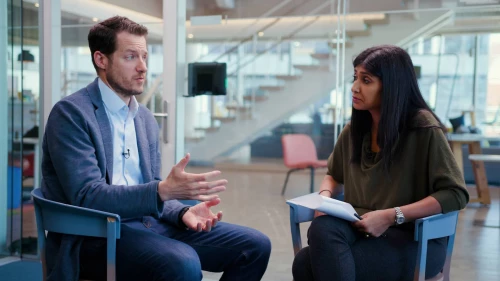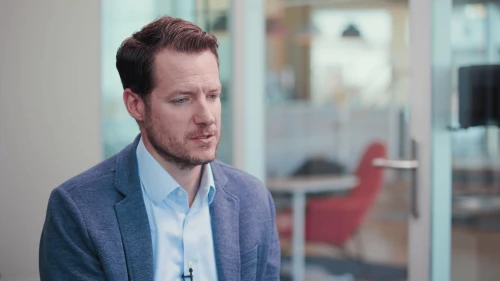It seems like a paradox. How can a company base its competitive advantage on something that belongs to everyone? Yet, in many ways, that’s the bet IBM made with its landmark $34 billion acquisition of Red Hat, a leading provider of industrial-strength Linux and other open source technologies that enable companies to work seamlessly across a hybrid cloud environment. Sushmita Banerjee—who leads BCG’s global Strategy practice—explored that question and more in a conversation with Roger Premo, IBM’s general manager of corporate strategy and ventures. The interview has been edited for length and clarity.
Roger, the landmark acquisition of Red Hat is a clear milestone in IBM's strategy. What drove it?
Premo: I'd say it represented the start of what we call our “hybrid cloud and AI strategy.” If you look at IBM before the acquisition of Red Hat, it sat in a place where I'd say arguably it had a few different strategies running in parallel. We had the Watson health business within the healthcare space. We had a managed infrastructure business. We had the rest of IBM. And those different paths didn't have a logical connecting point often in terms of our clients.
At the same time, there's this problem emerging for our clients and it's kind of circa 2015, 2016, when the thinking on Red Hat was emerging. Clients whose IT had always run in data centers were getting onto clouds, and there were clients that were deliberately moving onto multiple clouds. There was this path of increasing heterogeneity inside the enterprise, and it was creating a real tax on innovation and operating expenses.
The combination of a company that was trying to find a strategy paired with massive difficulties for our clients and a technical solution that actually unlocked value was fortuitous. The open source layer could be the abstraction layer that ran across that heterogeneity. And Red Hat was the leader in that space.
Looking back a few years later and, luckily for us, a lot of the vectors have moved in the right direction so that all those bets that acquisition was premised on really have paid off. So you take what was—still is—the biggest acquisition in the history of software and now it looks like a steal with all the benefit it's driven for IBM.
So, as you say, it's a steal. How do you think of competitive advantage in an open source world?
Premo: This urgent need to do digital innovation means that no one vendor can tackle all of that. So first off, you start with something where you're growing the pie for the end client, you're growing the pie for the technology partners that help serve that client. First and foremost, you recognize that when we partner, it creates value, and there's plenty of value to be shared with the client and the partners involved.
The heterogeneity is not solved by any of the individual public clouds. So, on one side, these public clouds have now become our partner because they want to deliver in those environments. Our competitive advantage versus any of the incumbent clouds is that we can run across them.
When something has to connect many to many—many underlying platforms to many different end-user applications on top—open source tends to emerge because everybody can contribute and bring their integration or adaptation to that open source. The collaborative economics work, while a commercial vendor would just be tapped out.
The things we're really working on right now center around a strategy of a common open source abstraction layer as a place to innovate for the business. If I go back to my prior consulting experience, in a process re-engineering project, standardization is the biggest lever that drives the most value. And really, we're selling standardization. But that's a heavy lift. If you say that I'm an incumbent company and I've already got technologies implemented in different ways, clients see the benefit. But the difficulty of getting there is hard. It’s our job to convince them.
And then if you look at those heterogeneous, complex environments, they are so massively complex, where a lot of those cloud environments are often charged by the second. The traditional IT administrator can't manage that anymore. You need AI to effectively manage that technology complexity. More than ever, we see those hybrid cloud and AI strategies being complementary and benefiting each other.
As one of the biggest players in the field, how are you thinking about responsible AI?
Premo: I think there's a spectrum of alternatives. One is I'm going to do an open experiment on the human population and see what happens. There's another that is full head in the sand: we're just going to avoid this technology. We think that there is a thoughtful middle ground that allows you to use the potential of this technology, but do it in a responsible way.
And while we do think that the government should play a strong role in regulation, we have a slightly different perspective. We don't think that there should be the equivalent of, say, the International Atomic Energy Agency for AI. We think all the agencies that are regulating different parts of the economy need to build AI skills to really effectively regulate it in a way that allows those industry sectors to function at full efficiency. So we're a very strong advocate of government regulation here, but we want to do it in a thoughtful way that gets most of the benefit of this technology in a way that's responsible for society.
It's always easier to imagine the efficiency side of these technologies: all the jobs that might be changed or lost. It's very hard to foresee the effectiveness side of it. Just like the internet or mobile, they've created so many more jobs and had productivity benefits on society that have been greater than their downsides.
The innovator community will find the opportunities, so we're betting on the field. We announced our Watson X platform, which is our foundation model platform. The other thing we've bet on is that, for enterprises, there will be a set of use cases for which you can use an API to generate the first draft of something. But if it's running the core business, if it's a medical diagnosis, where there are real business outcomes or lives on the line, you're going to want to have a higher level of trust, governance, and certainty on that model.
We put a lot into everything from a set of models we build with a kind of data provenance. They begin with clean data so you know that what you get out won't be a bad answer, and then add governance to watch the bias and risk around it when it's in operations for the enterprise. A lot of our bets have been around that at the core.
You’re placing a lot of small and large bets. Not all will succeed. So how is the organization, the leadership, thinking about managing failure to get the organization to embrace risk?
Premo: Well, I'd say, first of all, from my strategy lens, if I think about what we've announced on AI, or if I think about the core hybrid strategy, I think all good strategy leaders are paranoid optimists.
It's this combination of setting a bold direction, but almost with the same energy, having the paranoia of unpacking where it could go wrong. So, on everything we're doing, I've got high conviction in our ability to succeed. It's on us to execute. And then I think the rest really relates to the contingencies you put in different plans. Do you have the financial flexibility to allow some level of underachievement without jeopardizing the rest of the business?
I also run our ventures unit and see it in real time there. You have some home runs and you have some that are strikeouts. You have to have a financial objective that takes all of those outcomes into play and not be a pessimist, because I think if you plan on pessimism, you're going to actually deliver to it and underachieve the business. But don’t have irrational exuberance either, because if you're betting, frankly, the business, your client outcomes, and the careers of your employees on that, then you're doing everybody there a disservice.








